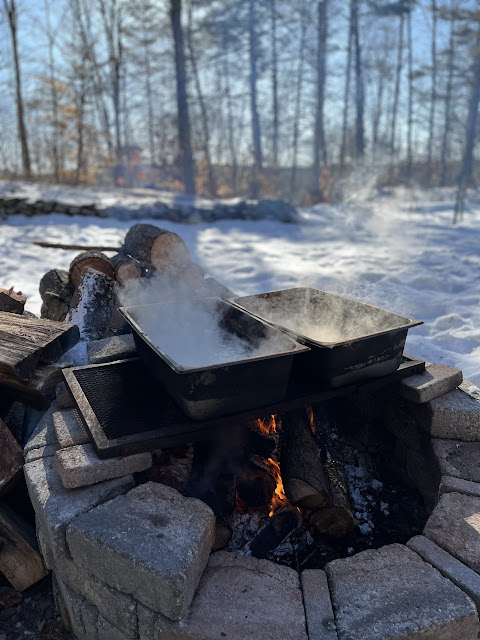Maple Syrup season has arrived with the sap dripping a bit earlier this year than the past few seasons. Winter seemingly has become quite unpredictable around here as rollercoaster weather patterns blow through with temps dipping into the -20s followed by 50 degree afternoons only days later. I've noticed the ground doesn't seem to maintain that hard frozen crust as winters 10 years ago seemingly always did and instead there seems to be lots of fluctuation with rain and ice constantly freezing and thawing leaving a muddy mess of slick frozen puddles around the landscape as we slowly spin around the sun wondering what to expect from this ever changing climate and how to properly plan our plantings and focus here at the homestead.

This year we tapped 14 trees and hung 16 buckets as our syrup supply has dwindled down to the final 750ml bottle from last year and I wanted to explore some new tree options that I have been eyeing up. It always humbles me to realize the more you immerse yourself in the landscape, the more knowledge and understanding emerges with it... making me realize how disconnected we have become from the land and how little inherent knowledge lingers from the our ancestors and the indigenous people that inhabited this land. Making maple syrup grounds us into those traditions of the past, creates awareness as to the seasonal nuances and patterns of nature all while humbling our place in the world.

Tapping begins with drilling a deep 5/16" hole into the tree at a slightly upward angle. Tradition states that you should locate your hole on the south facing side of the tree and following a vertical line with a major branch is also said to release the optimal amount of sap from each tap. After that you bang in the spiles and hang the buckets, threading the lids through the hole in the spile to better secure the setup to the tree. We have been very happy with the plastic buckets from our Canadian friends up north at
CDL. Occasionally they get blown around a bit but I've learned to always keep a inch or so of sap in the buckets to help give them a little more weight on the windy days. I like them because the worry of rust isn't a factor and the less hefty weight makes it a project that our little one can always take part in. She is becoming a pro after a few years of helping... she knows all the steps of the process and makes sure no step gets neglected.

Within a few minutes of hanging the buckets that telltale sound of drip drip was vibrating through the forest and you could almost hear the landscape thawing in the midday sunshine.
A few days into the drip and we already have about 20 gallons collected... with 3 more days till our first boil I predict an easy gallon of syrup for our first week of the season! It's a nice routine to come home from work and collect the sap into 5 gallon containers. We then bury the jugs in a big snow pile on the shady northside of our home to keep it cold till boil day! The other plus to the plastic buckets is you can see the amount of sap in each bucket from a good distance away so I always stay on top of collecting and never waste a drop!
A quick strain through some mesh into a 5 gallon water jug is the only prep we need before boil day. Luckily a good snow pack makes for easy storage but all sap should be kept cold and boiled down within 5-7 days of collection. I always slurp up a few handfuls of the first drips of the season. Its so subtle yet refreshing to taste the forest nectar on my lips and the ceremonial sip just gets me stoked for boiling the season ahead!

Our deer friends have been making daily appearances around the homestead, every maple season I notice them starting to forage the vast amount of hemlocks that surround our forest. Its these patterns and observations that help us better understand nature and its interdependencies. The natural beings of the world just seem to effortlessly integrate into the environment. I have been immersing myself deeply into the study of mycology this winter as we start to explore the possibilities of cultivating a vast network of fungus around the homestead. Playing with spores and identification methods as well as learning the history and folklore behind this integral part of our universe has humbled and inspired me to start constructing a dedicated mushroom lab in our cellar. Learning to identify the different species of trees and really paying attention to the lay of the landscape and where the rain collects is an integral part of foraging wild mushrooms and as my knowledge and experiences increase the connections and symbiotic relationships of the forest inspires me, encourages me and most important humbles me.

I have also found some time to let some of this inspiration flow freely through the Rootcellar Studio and have some new works underway along with a few finishing touches being done on some previous commissions.
More to come as the sap starts boiling, the spores begin to colonize and our homestead continues to evolve with our passions and inspirations!

















